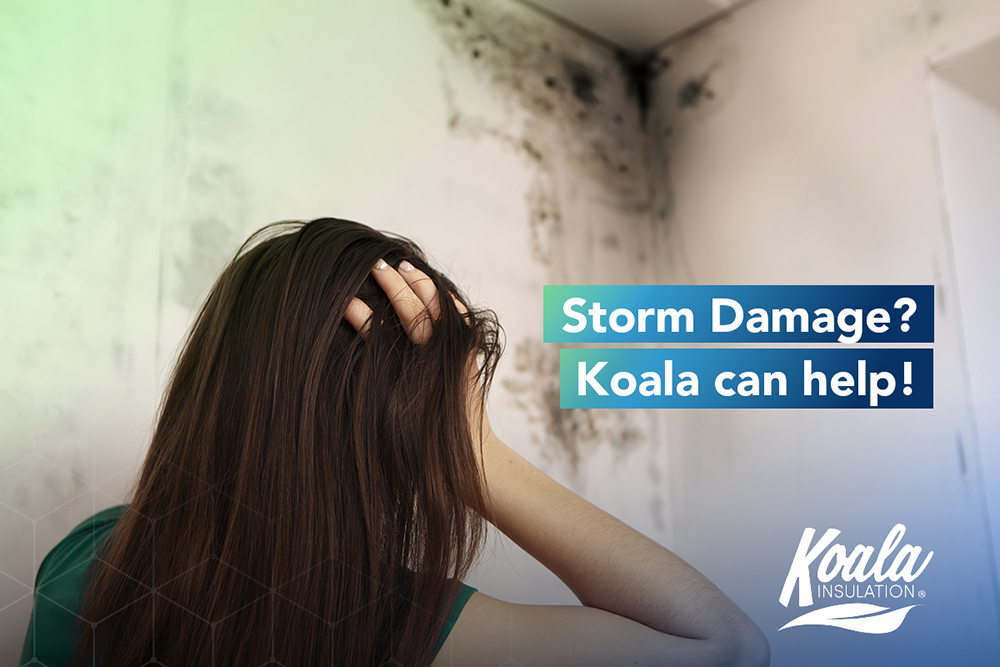Storm damage? Here’s what you need to know about your insulation

Storm damage? Here's what you need to know about your insulation.
Has your home been affected by water due to a storm? Understand what you need to do with wet insulation segments in walls, roofs, ceilings, and floors.
Few things are more devastating than a weather event invading your home. And it can be overwhelming to deal with – where do you start when a tree has come crashing through your roof after a storm? This recently happened to many homes in the Southwest Florida area.
At Koala Insulation of West Florida, we are here to help. Here are some practical tips on what you need to consider when your insulation segments have gotten wet, whether they're in your roof, ceiling, walls, or under your floor. If you need more information or want to get someone out to help, please call us at (941) 500-4000.
Assessing the damage to your insulation
The first step after damage to your home is contacting your insurance company. However, if you want to have some idea yourself and you can safely view the insulation, here are some questions to consider:
Is the insulation completely saturated or only slightly wet?
- If it is entirely saturated, it will require replacing. Even if dried out, it will not recover its original thickness, so its insulation effectiveness will be significantly reduced.
- It can be dried out, reinstalled, and reused if it is slightly wet due to minor leakage through the roof or floor.
Is the insulation torn, damaged, or compressed by the building damage?
The good news is, if only a few segments are damaged, you only need to replace those.
- If the segments or blankets are still intact and full-size, then they may be able to be reinstalled, depending upon the saturation factor.
- However, if the insulation is torn or shredded, you must consider replacing it. You can install pieces of insulation, such as off-cuts, into space, but fiberglass insulation depends upon full coverage to be effective. Otherwise, heat can escape through small holes and openings.
What to Do About Different Types of Wet Insulation
Various types of insulation respond to moisture differently. Some aren't damaged, others must be dried to prevent mold growth, and others will still need replacement. Use the following information to act once you realize your insulation is wet.
Wet Spray Foam Insulation
You know your home has spray foam insulation if wall and floor cavities are filled with rigid white foam. Though spray foam doubles as a moisture barrier and creates an air-tight seal, the leak is still problematic because water can damage the wood surrounding the insulation. Find and seal the hole to protect your home's porous structures from moisture damage.
Wet Fiberglass Insulation
Do you see pink batts or loose-fill insulation in wall and floor cavities? If so, fiberglass insulates your home. This material consists of tiny strands of glass, so it doesn't absorb water. However, when moisture fills the air pockets between the fibers, the insulation loses its ability to slow heat transfer. After all, water is a conductor, so wet fiberglass insulation is about as effective as no insulation at all.
To help fiberglass insulation dry out:
- Place a dehumidifier or fan in the area.
- Contact a professional to remove the affected batts and transfer them to a warm place to dry.
- Once dry, return the insulation to the wall or floor cavity.
- Inspect the fiberglass again in the next few weeks, and if it starts to emit an odor, it is contaminated with dirty water. It would be best if you replaced it to avoid affecting your indoor air quality.
As always, we do not recommend doing these tasks on your own. Call on your trusted insulation experts at Koala Insulation of West Florida to get the job done correctly and safely.
Wet Cellulose Insulation
You have cellulose insulation if you see loose, gray fibers in wall and floor cavities. Cellulose is made primarily of recycled newspaper, making it a plant-based product that can be difficult to restore after getting wet.
If the portion of wet cellulose insulation is small enough, you might be able to have it removed, let it dry for a few days, and then put it back. However, if the leak had been more extensive, a more substantial portion of the insulation may have gotten wet. Mold can begin growing within just a few days, so total removal and replacement may be necessary.
With this in mind, assessing the insulation after a weather event impacts your house is always a good idea. Koala Insulation of West Florida has a network of installers available to come to you and offer advice. Contact us for help.
Find Your Location


Get a quote


